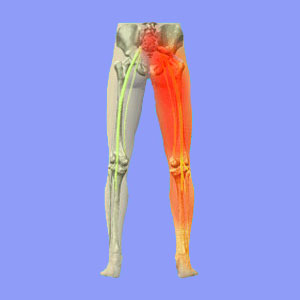
Sciatica from standing describes back and leg pain which occurs when the patient is forced to spend time on their feet. Some patients suffer symptoms immediately, while others only begin to feel their sciatica after an extended period of time standing.
Standing is obviously not inherently painful unto itself, but still causes agony to many sciatica patients, especially after a prolonged time in one place. It is clear from research that some cases of standing sciatica are obviously caused by some pathological process in the spinal anatomy, while others may be due to a psychological conditioned response and not any particular structural abnormality or anatomical issue.
At least in these circumstances, the reasons for the symptom generation or escalation are known. Worse still are the many cases of standing-related sciatica which are deemed completely idiopathic.
This treatise will explore the possible explanations for why a patient might suffer the commencement or worsening of sciatica symptoms from standing upright.
Reasons for Sciatica from Standing
Doing anything for too long can be painful even for the healthiest person on the planet. People who spend all day on their feet, standing in one place, can expect to be sore and tired by evening. This is normal. However, most patients who report feeling sciatica pain while standing typically get the symptoms after only a few minutes. This is illogical in most cases, especially when there is not a clearly defined and ironclad reason for the symptomatic expression to occur.
The majority of patients I meet have clearly been psychologically conditioned to expect pain while standing, so it is of no surprise to me that pain comes to them as soon as they are standing in one place for too long. This is true regardless of whether there is an actual bodily cause or not which may logically explain their suffering.
Sciatica Conditioning
Chronic pain is usually a mindbody disorder. It may be purely caused by the emotional mind, but in more cases, features at least some contributory factors. For example, a great number of chronic pain syndromes have a physical basis, but are worsened or perpetuated by the mind.
Conditioning is one of the most critical factors in how and when a person will experience their particular type of pain. Standing often involves a stressful situation, being that it is typically linked to work duties, impatiently waiting or fulfilling personal responsibilities.
Stress is the ideal time for ischemia to strike, since the subconscious mind is striving to distract the consciousness from concentrating on problematic emotional concerns at that very moment. This is precisely why most patients have pain while standing, sitting, lying down or doing any other harmless activity. The pain simply is programmed into their behavior pattern as something which will occur whenever an activity is performed.
Of course, the mind will choose to program patterns which are unavoidable and common, making the distraction work full time and recurrently. Furthermore, the sensitive emotions are often related to the circumstances in which the trigger occurs. For example, if standing is needed for a person to work, the underlying stress generator might also be a work-related occurrence.
Sciatica from Standing Facts
Standing is not bad for you. Unless you have a very rare spinal condition or have recently suffered tremendous back injury, standing should not hurt you. However, if you believe that it will, you will experience pain every time.
Dr. John Sarno, and many other enlightened doctors who treat mindbody sciatica, write extensively about conditioning and how it relates to physical pain. Luckily, overcoming this burden is as simple as deprogramming yourself using the alternative medical tactics offered by knowledge therapy. The treatment is effective and simple for anyone to use and best of all, involves no costs or risks whatsoever.
Of course, not all standing-related sciatica is of mindbody origin. In many patients, there is a physical basis for the pain, although conditioning will still play a part. Spinal stenosis in the lower back is the most well known causation of sciatica from standing. This is because when the spinal canal is straightened, it is less patent than when bent, such as when seated. A straight canal can increase the compression of neurological tissues considerably.
There may also be muscular reasons for pain while standing, such as abnormally tight hamstrings or muscle imbalances. Piriformis syndrome can also act up when standing for too long.
All these factors should be weighed when evaluating the incidence of standing sciatica and a determination should be made if there are physical factors which need to be addressed to stop the pain or whether there are no logical anatomical reasons why standing should worsen the symptoms. Your physical therapist will prove very useful during this process, so be sure to consult with them for additional detailed information.





